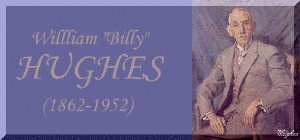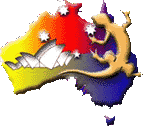|
      |
Probably best known for his gallant war efforts, earning him the nickname "the little digger," Billy Hughes was born in London on September 25, 1862 of working class Welsh parents. He qualified as a teacher, emigrated to Australia and worked as a stockman, a factory hand, a stone breaker, an actor, a ship's cook, a railway fettler, a bookseller and in 1890, became the organiser for the Australian Workers Union. He was involved in various union activities before winning a seat in the New South Wales Legislative Assembly in 1894. He opposed Federation but entered federal politics and became a founding member of the Commonwealth Labour Party under the leadership of John Watson. He married Elizabeth Cutts in 1886, who gave birth to six children and died in 1906. In 1911 he married Mary Campbell, who was made a Dame Grand Cross of the Order of the British Empire in 1922 in recognition of her services during World War I. Deputy leader of the Labor Party under Fisher, Hughes held the influential Attorney-General portfolio. In October 1915 he became prime minister on Fisher's resignation and threw himself wholeheartedly into the war effort. In January 1916, he set out to Britain to argue for more Australian participation in deciding the conduct of the war, and whilst there purchased, without reference to Cabinet, a fleet of 25 ships to form the basis of the government-owned shipping line (sold off in 1928). Then Hughes toured the western front, where the Australian Infantry Force welcomed him with open arms and nicknamed him "the little digger." Hughes believed it was Australia's patriotic duty to send more troops to help Britain, which could only be achieved through compulsory conscription. The country was divided. Even though the Labor party was anti-conscription, Hughes persuaded Cabinet to hold a referendum. In the midst of heavy losses on the Somme, the first referendum on compulsory conscription was rejected by the people. With this rebuff and the resignation of five ministers, Hughes walked out of the party room and formed the National Labor Party with the support of Cook's Liberals. Pressure to form a wartime national coalition failed because the Labor Party refused to serve under Hughes. In February 1917, the National Labor Party and the Liberals merged to form the National Party. Hughes held another referendum on conscription in December 1917, which was also defeated. Hughes resigned, but as there was no one else who could take over he remained the prime minster. In April 1918, Hughes and Cook travelled to London to attend the Imperial War Conference and to see the war at first hand. He was in London when the armistice was declared and insisted on an Australian seat at the Versailles Peace Conference. He clashed with Woodrow Wilson and with the Japanese prime minister, who suggested that the principle of racial equality should form part of the League of Nations Covenant. Hughes was triumphantly re-elected in December 1919. The next three years were made difficult by conflicts between Hughes and the Country Party. In 1923, after seven years as prime minister, he was forced to resign and retire to the backbenches. Hughes did not go quietly. In 1929 he forced the resignation of Bruce. During the Depression he attempted but failed to gain support for a new political grouping, the Australia Party. In the '30s, he joined the United Australia Party and held several political posts under Lyons, whom he criticised for not recognising the need to prepare for war. Hughes became leader of the United Australia Party in 1941, and worked with Labor on the 1941-45 Advisory War Council. Hughes remained a member of Parliament until his death in 1952, having completed 51 years as a federal politician and being the last member of the original 1901 Parliament to occupy a seat. Copyright unknown
|
|
|
|
[ Virtual
Australia | The
World We Live In | The
Things We Do ]
Problems/Broken Links can be reported
to
All text and
graphics unless otherwise stated are ©1998-2000 Kim Holden, Virtual Australia.
|

![[Visit Oska]](../../images/oska003.gif)
